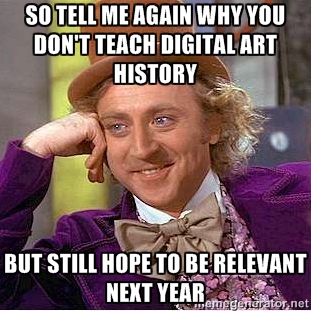Nancy Ross is an Assistant Professor of Art History at Dixie State University in St. George, Utah and a speaker at THATCamp CAA 2014. She led the TICE ART 1010 development team in 2011 and is the Contributing Editor for Medieval Art for Smarthistory at Khan Academy. She blogs about teaching art history at experiementsinarthistory.blogspot.com/.
The working title for her THATCamp presentation is “Students Respond to Teaching Twentieth Century Art History with Gender and Data Visualizations.” In my Twentieth Century Art History class last spring we focused on female artists and created a data visualization on the social networks of female artists. This presentation will highlight the project and student responses to the project.
*
Murtha Baca and Anne Helmreich outlined five phases of digital humanities that serve as a model for digital art history. Their work is valuable to me as I try to find my way through research projects that fall within the purview of digital humanities and figure out a research direction for the future. But I think that they miss a key step, which is the teaching of digital art history. And not just to grad students, but to undergrads too. Perhaps especially to undergrads.
Many of our undergrads live in a digital world. When we discuss, learn about, and research art history using social media, online content, and digital tools, we are discussing art history in a way that will make more sense to them than learning out of a traditional textbook, which they may or may not be able to understand. I recently gave a talk at Weber State University where I presented the idea that our traditional textbooks are rendered useless if our students do not have college-level reading skills. I saw a lot of faculty heads nod in agreement. This is the reality that we encounter when we teach at open-admissions institutions. We spend a lot of class time remediating textbook reading assignments, which reduces the amount of time that we spend on other learning activities.
Today, digital textbooks like Smarthistory at Khan Academy can replace traditional ones, especially when we use them in combination with other digital teaching resources, most of which are freely available online. But teaching digital art history isn’t just about replacing a textbook with online content. It’s about creating new narratives in art history and allowing our students to share in that process. If we want to understand the sexist and racist underpinnings of the art history that we’ve learned throughout our careers, practicing digital art history in the classroom will help us get there. There is no better way to stick it to The Man than to text-mine The Man’s writings and reveal his biases.
We don’t have to know how to code to teach digital art history in the undergraduate classroom, as there are plenty of tools out there that we can easily use to demonstrate the principles and benefits of digital art history, whether they are online (perhaps translated) texts, Google image searches, text mining tools, or data visualization tools. We can be as sophisticated as Omeka or as simple as Pinterest when we teach students to collect and analyze art for themselves. Perhaps we may even venture as far as spreadsheets and databases, quantifying and coding, all the while tweeting their process, observations, and questions for fellow students and scholars beyond their classroom.
Digital research/teaching methods help our students develop critical thinking, especially as they encounter and challenge the way that art history is presented to them. Learning digital art history allows students to experiment with constructing their own narratives of art history, fully immersing them in the research process. Our students needed digital art history yesterday.




